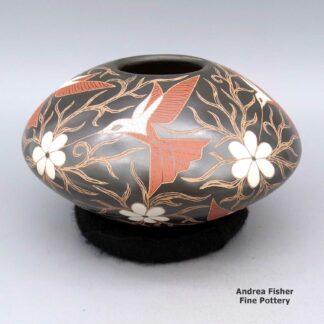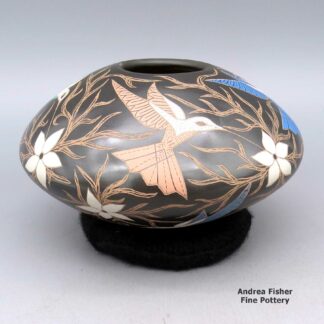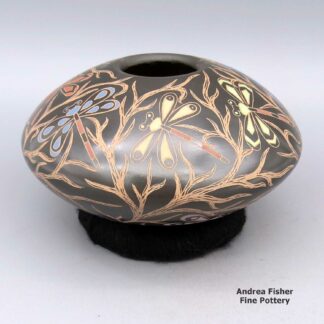Sgraffito-and-painted
About Sgraffito-and-Painted Designs
Sgraffito is the technique of etching (scratching) the surface of a pot to create a design. That "etching" can happen either before or after the piece is fired. Sometimes an artist will etch before and after, depending on the purpose.
Painting refers to making some part of a piece a different color, usually using a brush but can also be done with a cloth (slipped). Sometimes a piece is slipped completely, using various colors of clay or crushed mineral in the slip before it is etched, sometimes after.
Sgraffito-and-painted techniques are relatively recent developments in the world of traditional pottery. In the world of the Hopi, multiple male potters are also a relatively recent phenomenon and, while most learned their craft from their grandmothers, mothers and sisters, they were required to find another form to create and different decorations to work with when they went commercial. While some produced seed pots and jars decorated with sgraffito geometric designs, Thomas Polacca branched into carving, etching, slipping and painting his seed pots and a whole new form and mode of expression came into being. Many of his descendants (and others) have followed the path he created.
At Ohkay Owingeh, Alvin Curran and Tom Tapia were in similar positions: male potters in a world of female potters. Both developed their own lines of design incorporating carving, sgraffito, slipping and painting into their work, differentiating themselves from the women artists.
At Santa Clara Pueblo, Joseph Lonewolf, Camilio Tafoya, Corn Moquino and others introduced the sgraffito technique to the pueblo's potters, but then a few took it further and painted more details into their work after they'd etched it.
Many of the potters working in the Mata Ortiz area have never produced their art any other way, and many of their versions of ancient subjects are timeless.
Showing all 4 results
-

Elicena Cota, zzcg2j320m3, Polychrome jar with hummingbird, flower and branch design
$275.00 Add to cart -

Elicena Cota, zzcg2j320m4, Polychrome jar with bird, flower and vine design
$275.00 Add to cart -

Elicena Cota, zzcg2j320m5, Polychrome jar with dragonfly and vine design
$275.00 Add to cart -

Joseph Lonewolf, zzsc2k018: Miniature polychrome seed pot with sgraffito design
$1,650.00 Add to cart
Showing all 4 results